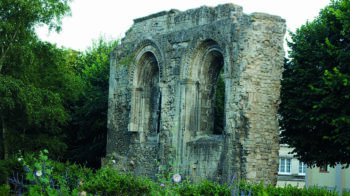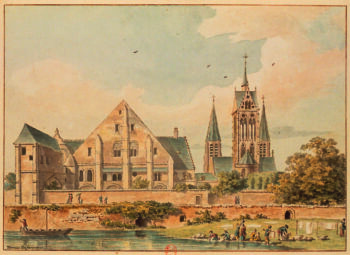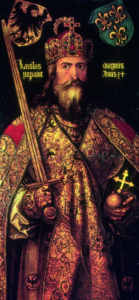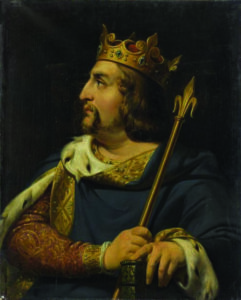The Lady’s Slipper
How was Mary, the Mother of God dressed? At her marriage to Saint Joseph, it is likely that she was dressed elegantly in a long, blue linen dress with sleeves and an underdress of fine silk, as Jewish maidens were. She did not go barefoot, although some of the apparitions might suggest this. Presumably she wore sandals or slippers, the national footwear at the time. A slipper of hers, reputed to have worked many miracles, was preserved for many years at de Soissons in northern France.
Notre-Dame de Soissons was originally a nunnery that was founded under the Merovingian dynasty, a ruling family of the Franks, a German-speaking race, that dominated France, Belgium and west Germany in the middle of the fifth century until ad 751. After the fall of the Roman Empire, it was the largest and most powerful regime in Western Europe. In the middle of the fifth century, the nunnery received a monastic rule (a religious way of life, renouncing worldly pursuits) from Drausinus, bishop of de Soissons. By 660, the abbey was home to noble and royal women.
In later years, the abbess was Gisèle, the sister of Charlemagne or Charles the Great, King of the Franks and ruler of Western Europe from 768 to 814.
Between 1130 and 1160, a new abbey was constructed at de Soissons. The planning of this project was an overriding problem for the nuns, but it was successfully completed during the abbacy of Mathilde I, who died in 1143 and was replaced by Mathilde II.
Notre-Dame de Soissons was once one of the largest abbeys in France, which was famous for its many relics, including the slipper of the Virgin Mary. Owning an object that had power beyond its material qualities generated not only revenue for the abbey but was of special significance for the community.
During the twelfth century, harsh weather and seasonal droughts resulted in poor harvests and led to an outbreak of ergotism in areas of northern France. This so-called ‘plague of fire’ was a fungal infestation in rye and wheat, which produced vomiting, muscle weakness, convulsions, coma and even death. The outbreak also affected Paris and Artois. It affected young and old and countless were marred by famine and disease.
Between 1128 and 1129, crowds teemed to de Soissons, where more miracles were reported than in other cities. These were attributed both to the intervention of the Slipper of the Virgin Mary or Our Lady of de Soissons and to Mathilde I, who encouraged sufferers to attend a novena (special prayers on nine successive days) to the Virgin Mary and to receive the blessing of the slipper. Some turned to penitential practices, such as fasting and almsgiving, but more was needed in this epidemic.
Mathilde encouraged the afflicted to pray earnestly. The first reported miracle was in a girl whose convulsions and weakness were ameliorated when she was blessed by the slipper of the Virgin. She was later pronounced cured. Within fifteen days, 103 people were cured by Mathilde’s intervention. Many people were so overwhelmed by these healings that they remained in the church for days proclaiming their cures. Others withdrew to their homes to praise God and His Blessed Mother. Three girls, who were gravely disfigured, were restored to full health on touching the slipper.
As part of the healing ritual, Mathilde carried the slipper around the church, but it was also displayed to the sick and healthy to show the power of the relic. Mathilde is alleged to have compiled reports of the cures at the time of this outbreak. When she died, the nuns organised these reports into a ‘formal text of the miracles’ witnessed at de Soissons.
Another female, who regained her health on kissing the sacred slipper, seized the relic with her teeth. Mathilde regarded this as unacceptable conduct and directed that the slipper should be withdrawn from public circulation and venerated at a distance.
Pilgrims came from across many countries and took wood, food, earth that had touched the slipper. These relics provided not only cures for people unable to come to de Soissons but offered protection and enhanced people’s devotion. The slipper was now placed on the altar where it was enshrined and venerated. Servants, peasants and even non-Christians came and were cured at de Soissons. The Mother of God at de Soissons was now referred to as ‘Mother of Mercy’.
The penitential nature of the pilgrims was another unmistakable observation. Processions of the poor, the sick and the barefoot came to seek cures for their infirmities. The testimony of a dumb man, who had been cured, indicated that a more personal form of devotion seemed to be emerging. Such was this man’s devotion that he claimed he had seen Jesus and His Blessed Mother approach him and that She had touched his body and healed him. Young and old, the deaf and the mute showed devotion to the slipper and to its miraculous interventions in their lives.
Many argued that as the Virgin Mary wore slippers, it was not inconceivable that one might survive. This view was not acceptable to a knight called Boso, who came to de Soissons for a festival. Boso, incensed with anger, proclaimed that it could not possibly be the slipper of the Virgin Mary because it would have rotted away or fallen to pieces long ago. No sooner had Boso blasphemed against the relic than his mouth was twisted towards his ear and he was left in agonising pain. He hurried to the church and threw himself before the altar of the Virgin Mary. The abbess came and steered him closer to the altar. She blessed him with the slipper and very quickly he regained his strength and his disfigurement subsided. Boso later repented and ‘gave himself up to services of the church at de Soissons’.
There are very few descriptions of the slipper and little is known about its origin, or how the nuns at the abbey acquired it. The abbey held the slipper since its foundation. One possibility is that Charlemagne, who collected relics originating from the east, may have bequeathed it to his sister, the abbess Gisèle.
Records show that Louis VI visited the abbey during his reign from 1108 to 1137. When Mass was being celebrated, the king, an avowed sceptic of miracles, was visibly overtaken by the nuns’ profession of holiness and the alleviation of people’s infirmities and disfigurements. A woman carried a little boy, formerly infirm, to the king. The boy’s bearing indicated that, by the graces of the Virgin Mary, he had been cured. But it was only when the boy spoke to him of the wonders of the Blessed Virgin, that the king became convinced of these miraculous interventions.
Relics are regarded as a tangible means of connection with the divine. The slipper of the Virgin Mary was a means of connection and this was especially relevant for the sick and infirm. Such connections are relevant for a multiplicity of inclinations and social pressures, as was seen in the woman who tried to bite off a piece of the slipper.
The French Wars of Religion from 1562 to 1598, a conflict between Catholics and Huguenots, had a devastating effect on the abbey. Although the abbey was restored after this war, it never regained its former distinction. During the French Revolution it was partially demolished.
A single wall and two arched window frames are all that remains of Notre-Dame de Soissons, but it will always be synonymous with the slipper of the Virgin Mary.





 Entries(RSS)
Entries(RSS)